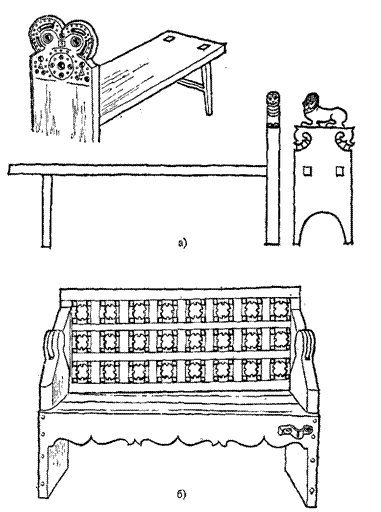
The basis of Russian wooden and stone architecture, which developed over the centuries, formed the type of peasant dwelling that was formed in ancient times - a wooden hut (Fig. 1). Huts - easily wearable buildings, we have reached the hut no older than the middle of the XIX century, but in their device they preserved the ancient building traditions. Usually they were erected from small-layer pines, and in some areas of the Mezen and Pechora rivers from larch. Some parts of the building were made of spruce, roofing material - ploughshare — from aspen. The diameter of the logs ranged from 25 to 50 cm, length 5 - 10 m.
The main tool in the construction of all Russian wooden structures was an ax, they chopped trees and turned them into logs, bars and planks, took out grooves and nests when tying log cabins, mostly performed and carved decorations. From here they say not to build, but to cut down the house. The saw began to be used at the end of the 18th century, and in some places from the middle of the 19th century.
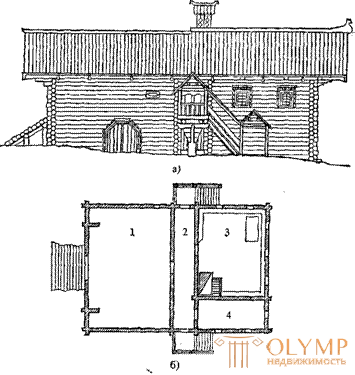
Fig. 1. Hut (Vologda region, XVIII century): a - general view, b - plan of the residential floor; 1 - barn, 2 - porch, 3 - hut, 4 - crate
Structurally, the huts were solved in the form of a square or rectangular frame from the crowns forming the walls — rows of horizontally laid logs tied at the corners with cuttings (oblo, paw, hat). The dimensions of the log cabins were determined by the length of the logs, since the Russian carpenters almost never used the logs spliced along the length. When building large areas, such as churches, they used an octagonal frame (octagon), which, with the same length of logs, made it possible to cover an area about three times larger than the square one. Porch leaned on the pillars. The windows in the chopped walls made “portage” and “red”, or “squinting”, the door panels were smooth, and then they were painted and equipped with iron door hinges and lock guards rich in design.
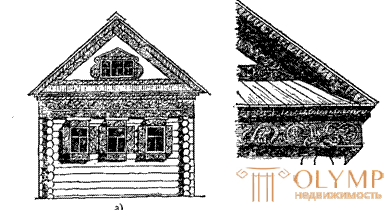
Fig. 2. The carved decoration of Russian huts near Kostroma (a) and Arzamas (b)
Decision plan huts is simple and concise. The hut is united under a common roof with outbuildings. The exterior of the hut is characterized by a picturesque asymmetry in the placement of the porch, gate, importation, courtyard and windows, which gives a special comfort and intimacy to the Russian peasant dwelling. Window and door openings, valleys, roofs, pillars of the porch and refectory in monasteries, pilahs, i.e., log brackets supporting roof overhangs, were decorated with carvings (Fig. 2). The carved ornament was simple and strict; it was made with an ax, chisel and knife. The decorative design of the bearing pillars included the alternation of interceptions of carved cords and melons (Fig. 3).
Outside, in places protected from rain and snow (on the lower surfaces of the roof overhangs, on the upper parts of the walls and in the recessed parts of the thread of the window and pillar trim, porches), and inside the hut they used painting and painting.
The peasant dwelling consisted of a cage, a hut, a porch, an upper room, a basement, and a closet. The main living room is a hut with a Russian stove. The internal situation (Fig. 4) of the hut was based on the stability of the traditions of the peasant's household and economic life, which, in turn, was determined by the centuries-old static economy and life: fixed wide benches.

Fig. 3. Carved wooden pillars in Nikolskaya (a) (p. Shikhno) and Petropavlovsk (b) churches (XVIII c.)
Particularly interesting in the interior of the Russian hut is the device of the furnace (Fig. 4). Combined with its wooden parts with the internal architecture of the hut into one whole, it embodies the idea of a home. That is why so much love has been invested by folk craftsmen in the architectural processing of the furnace and its wooden parts. The loose ends of the thick bars of the mid-furnace, supporting the heavy furnace hearth in the front and the bench-bench on the side, were treated with an ax in expressive forms corresponding to their purpose as heavy load supports. The stove oven, fencing off the stove pole, was hewn with an ax in the form of bold bends of the horse's neck.
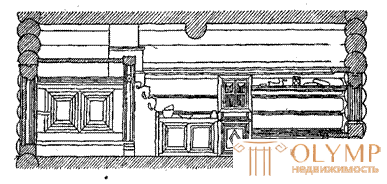
Fig. 3. Internal view of the hut (Vologda region, XVIII century)
The stone bulk of the furnace does not grow directly from the plank floor, but has a gradual transition in its wooden parts. The desire to give beautiful details to wooden details, as well as to express aesthetic inclinations in the laying itself, leads to the creation of the artistic integrity of the entire structure. Approximate correctness of furnace eaves, hollows of stoves and other hand-made parts of the furnace are in complete harmony with the surrounding wooden parts.
Sometimes a stove corner was made for cooking, separated by a wooden panel with a brightly painted partition that did not go all the way to the top. Often this partition turned into a two-sided and painted built-in wardrobe. The painting was either geometric in nature (motif of the sun), or depicted flowers. The paintings were dominated by green, white, red, pink, yellow, black colors.
Fixed benches are usually arranged along the walls of the entire premises. On one side, they were tightly attached to the wall, and on the other hand, they were either supported by stands made of thick planks, or by carved and chiseled posts — legs (Fig. 6). These legs were narrowed to the middle, which was decorated with round chiselled apple. If the stand was made flat, sawing from a thick board, then its drawing would retain the silhouette of a similarly shaped foot. To the edge of the bench sewn gum, decorated with some simple carving. A shop decorated in this way was called pubescent, and its legs were called stamishkami. Sometimes between the stamish-kami organized sliding doors, turning the wall benches into a kind of lari for storing household things.

Fig. 5. A schematic representation of the furnace: 1 — sub-otopes, 2 — basket, 3 — oven column, 4 — shtochnitsa, 5 — heel, 6 — mouth of the stove, 7 — brow, 8 — boil-off, 9 — horseman, 10 — stoves, 11 — Vorontsy, 12 - mother
A portable shop with four legs or with blind boards replacing them on the sides, on which the seat was approved, was called a bench (Fig. 7, a). The backs could be thrown from one edge of the bench to the opposite (Fig. 7, b). These benches with reversible back were called peremetnymi, and the back itself - peremet. The carvings were mainly decorated with backs that made deaf or cross-cutting - carpentry-lattice, carved or turning work.

Fig. 6. Stalls (Russian North, XIX century)
The length of the bench is somewhat greater than the length of the table. The benches in the upper rooms were usually covered with a special half-pot cloth. There are benches with one sidewall - carved or painted board. The sidewall was a cushion support or was used as a spinning wheel.
Chairs in the peasant dwelling spread later, in the 19th century. The influence of the city was most noticeably reflected in the decision of the chair. In folk art, the stable symmetrical form of a chair with a square plank seat, square through back and slightly curved legs prevails. Sometimes the chair was decorated with wooden fringe, sometimes patterned back. Chairs were painted in za-three colors, for example, in blue and crimson. For chairs, some stiffness and geometry are characteristic, which makes them in shape with a bench.
The table was usually of considerable size for a large family. The table cover is rectangular with a ratio of 1: 2 and 1: 5, made of good planks without knots and carefully processed to a special smoothness. The underframe was solved in different ways: in the form of wooden sidewalls with a notch below, connected by a piercer; in the form of legs, connected by two crosspieces or a circle; without or with a king; with one or two drawers. Sometimes carved covered the edges of the dining room and the edges of the massive legs, ending in its lower part with carved interceptors.
In addition to the dining rooms (Fig. 8a), they made kitchen tables for cooking — supplies that were placed near the stove. Postavtay were above the dining tables to make it convenient to work while standing, and had shelves with lockable doors and drawers at the bottom. Small tables were also distributed, on which a casket stood or a book lay, they had a more decorative solution (Fig. 8, b).
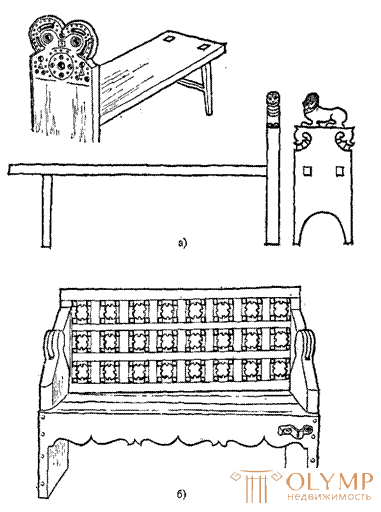
Fig. 7. Benches: a - Vologda region., B - with reversible back (Arkhangelsk region.)
Chests - mandatory accessory log. They kept clothes, canvases and other household utensils, the lockers made large ones up to 2 m long and small 50-60 cm (laying). The supporting part was solved either in the form of low legs, or in the form of a profile plinth. The lid was straight or slightly convex. Sometimes chests were covered with animal skin with a short nap (elk, deer) on all sides. Strengthened chests with metal parts, which also served as decorations. The metal stripes made a slotted ornament, clearly protruding against the background painted in a bright color (green or red) chest. Handles intricately decorated on the sides of the chest, the appearance of locks and keys. Locks were made with a ringing, even with a melody and a clever way of locking and master keys. Carved and painted chests were decorated inside as well, the most common theme was floral design. Especially richly and vividly painted wedding chests. Cedar chests were highly valued, the peculiar smell of which scares away the moths.
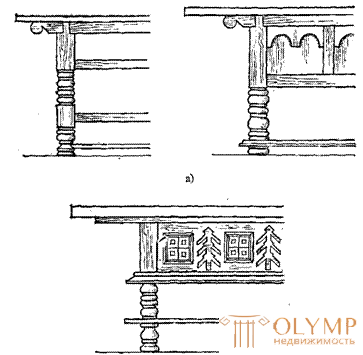
Fig. 8. Designs of dining tables of the XVII century. (a) and a small table with carvings (v. Trigorskoye near Pskov, end of the XVIII – early XIX c.) (b)
Widely used in the hut shelves, fastened to the wall tightly. The shelves adjoining the wall along the entire length were called hanging (from the word to hang), the shelves supported only by the ends were called Vorontsy. The Voronts regiments divided the hut into independent parts: at one end they rested on a pole or a bar near the stoves, and the other - entered between wall logs. To the shelves can also be attributed, and hinged flooring - rolls, which are made above the entrance door: between the stove and the wall. Fixed tent to the walls and on supports-pillars. Sometimes the beds were supplied with fencing of lathe balusters or profile boards.
Above the benches was a regiment-headboard, which was located slightly above the windows. These shelves were supported by brackets shaped figure.
Over time (XVIII — XIX centuries), cabinets of various sizes and types start to appear in peasant dwellings. Small cabinets are varied in decoration (carving, turning parts, profiles, painting). Patterns are geometric or floral in nature, often a flowerpot with flowers. Sometimes there are images of genre scenes. Often in the lockers used through-threading, which was done for ventilation products.
The cabinets consisted of two parts: the lower one was supplied with shelves with lockable doors or drawers (two to five) and had a folding board that was used as a table cover. In the upper part of the lower part there were shelves that were closed with hollow or glazed doors.
For sleep, benches, benches, chests with a flat lid, built-in and mobile beds were used. The built-in bed was placed in the corner, tightly fastened to the walls on both sides and had one backrest. Suspended cradles, cradles or cradles that were decorated with carvings, turning parts, paintings, and figured cutouts in boards were intended for infants.
The furniture of the Russian peasant dwelling is characterized by immobility, since it is solved as an organic element of the interior of the hut, taking into account living conditions. The horizontal rhythm of furniture dominates the interior of the hut, which is revealed in the horizontal position of the benches and benches, in the plane of the shelves and shelves, etc. The interior and its equipment are united by a single material, carpentry techniques, and décor. The natural color of the wood was maintained. The main structural elements of furniture - timber and board, which are connected on wedges and spikes.
The leading color scheme was golden-ocher with the introduction of white and red. Golden-ocher tones are characteristic of the walls of the hut, wooden furniture, dishes, utensils. The white towels were on the icons, the red color gleaming in small spots in clothes, towels, in the plants on the windows, in the paintings of household utensils.
The high art of artistic woodworking in Russia is reflected in the various ways of making wooden products and their decor. The earliest technique of carving was a flat-relief, which is characterized by shallow cutting, when the ornament (most often floral or geometric) and its background are at the same level. Flat-relief threads are subdivided into contouring, when narrow dihedral cuts, geometrically triangular-grooved, are applied with a knife, when triangular grooves — grooves are cut into the product’s surface with chisels of different sizes, and nail-grooved, when round-shaped hollows are made on the surface of the product.
Later, lathe artwork with painted or painted and burned found its distribution.
Folk craftsmen make extensive use of the natural beauty of various types of wood and cap roots (growths on trunks and roots of birch). A kind of artistic woodworking technique is birch bark.
Что бы оставить комментарий войдите
Комментарии (0)